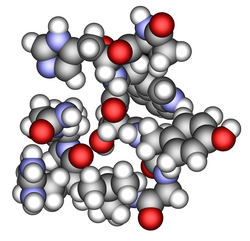Gonadoliberin
| Gonadotropin releasing hormone 1 | ||
|---|---|---|

|
||
| Dome model according to PDB 1YY1 | ||
| Properties of human protein | ||
| Mass / length primary structure | 10 amino acids; 1182 daltons | |
| Precursor | Progonadoliberin (69 amino acids) | |
| Identifier | ||
| Gene names | GNRH1 ; GNRH; GRH; LHRH; LNRH | |
| External IDs | ||
| Drug information | ||
| ATC code | H01 CA01 V04 CM01 | |
| DrugBank | DB00644 | |
| Drug class | hormone | |
| Occurrence | ||
| Homology family | Progonadol | |
| Parent taxon | Vertebrates | |
Gonadoliberin (synonym: Gonadotropin-Releasing-Hormon; GnRH) is a hormone formed in the hypothalamus , which stimulates the synthesis and secretion of the gonadotropins of the anterior pituitary in mammals and other vertebrates . Other names for the hormone are gonadorelin ( non-proprietary name ), gonadotropin releasing hormone 1 (GnRH1) or luteinizing hormone releasing hormone (LH-RH) or follicle-stimulating hormone releasing hormone (FSH-RH).
development
The gonadoliberin-producing cells migrate from the nasal placode into the forebrain during embryonic development . The cell bodies lie in the supraoptic region of the hypothalamus , and the axons of the neurons extend into the lateral median eminence .
structure
The human peptide gonadoliberin consists of ten amino acids , so it is a decapeptide with the sequence: pyro Glu-His-Trp-Ser-Tyr-Gly-Leu-Arg-Pro-Gly-NH 2 . The precursor of the peptide has a size of 69 amino acids. The gene locus of the coding DNA sequence is on chromosome 8.
Synthesis and secretion
Gonadoliberin is synthesized in the hypothalamus and pulsed at the eminentia mediana pulsatil , i. H. in bursts of 90 to 120 minutes, released into the blood via the hypothalamic-pituitary portal vein system. The pulse generator is the arcuate nucleus . The periodic form of stimulation is a prerequisite for gonadotropin secretion by the pituitary gland .
effect
The hormone stimulates the pituitary gland to secrete the hormones FSH and LH , which regulate the function of the ovaries and testicles . It works in the anterior pituitary gland by binding to a G-protein-coupled receptor ( gonadotropin-releasing hormone receptor ). Whose activation causes via the second messenger inositol triphosphate (IP 3 ) an increase in intracellular levels of calcium - ion (Ca 2+ ), leading to the hormone effect, d. H. the formation and secretion of the gonadotropins of the anterior pituitary gland. The aforementioned receptor for gonadoliberin is also formed in the mammary gland , lymphocytes , ovaries and prostate . The plasma half-life is less than 10 minutes.
Diseases
Genetic defects in the gonadoliberin receptor are cited as a cause of hypogonadotrophic hypogonadism .
Therapeutic use
Cyclical dosing
Gonadoliberin is used therapeutically in fertility problems in women to stimulate the function of the ovaries . To do this, the hormone is injected into the blood in spurts at intervals of 60–90 minutes using injection pumps. When it is effective, the hormone in the ovary induces ovulation . The alternative treatment through the administration of gonadotropin often leads to overstimulation and multiple pregnancies due to several parallel ovulations, which rarely occurs with gonadorelin administration.
Constant dosage
Long- term administration of GnRH analogues leads to a downregulation of the gonadoliberin receptors, which greatly reduces gonadotropin secretion. As a result, the formation of sex hormones in the gonads decreases and ultimately dries up completely. This effect is used in the treatment of precocious puberty , prostate and breast cancer , in endometriosis and mastodynia , and as a gender reassignment measure .
Trade names
Monopreparations
Kryptocur (D, A), LHRH Ferring (D), Lutrelef (D, CH), Relefact (D)
Web links
- Gonadoliberin. In: Online Mendelian Inheritance in Man . (English).
literature
- Thomas Küttler: General pharmacology and toxicology . Urban & Fischer, Munich / Jena 2002, ISBN 3-437-41041-5
Individual evidence
- ^ S. Wray, P. Grant, H. Gainer: Evidence that cells expressing luteinizing hormone-releasing hormone mRNA in the mouse are derived from progenitor cells in the olfactory placode. In: Proceedings of the National Academy of Sciences . Volume 86, Number 20, October 1989, pp. 8132-8136, doi: 10.1073 / pnas.86.20.8132 , PMID 2682637 , PMC 298229 (free full text).
- ^ S. Wray: Molecular Mechanisms for Migration of Placodally Derived GnRH Neurons. In: Chem Senses , Vol. 27, 2002, pp. 569-572, PMID 12142333 .
- ↑ UniProt P01148
- ^ Georg Löffler, Petro E. Petrides: Biochemistry and Pathobiochemistry . Springer, Heidelberg 2003.
- ↑ CA Flanagan, RP Millar, N Illing: Advances in understanding gonadotrophin-releasing hormone receptor structure and ligand interactions . In: Rev. Reprod. . 2, No. 2, May 1997, pp. 113-20. PMID 9414473 .
- ↑ M. Beranova et al .: Prevalence, phenotypic spectrum, and modes of inheritance of gonadotropin-releasing hormone receptor mutations in idiopathic hypogonadotropic hypogonadism. In: J. Clin. Endocrinol. Metab. , Volume 86, 2001, pp. 1580-1588, PMID 11297587 .